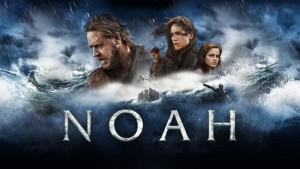 Legend has it that one day, during the pre-production of a film about the Bible, Dino De Laurentiis was on set with Robert Bresson.
Legend has it that one day, during the pre-production of a film about the Bible, Dino De Laurentiis was on set with Robert Bresson.
The well-known Italian Producer, looking out the window, saw, with amazement, huge cages containing pairs of animals, passing by. First lions, then giraffes, last hippos: for each species one male and one female. All going towards a hypothetical cinema ark.
De Laurentiis, gleefully rubbing his hands, went to the great French director and said, “Finally, Maestro, it seems I was able to get you in the making of a blockbuster.”
At that Bresson, approaching to the ear of the producer, said in a whisper: “You will only see their footprints in the sand.”
This film about Noah, needless to say, was never made. It passed into John Huston’ hands who turned the story of the flood into a tasteful lighter episode, even with ironic tones, between the murder of Cain and the Tower of Babel for his The Bible.
Today, so many years away from a legend that probably is not true, Aronofsky, faithful to the promise of Bresson (author so far from him) does not even let us see the footprints of the animals of the ark. Their presence in the film is not even a “Clue”: it is reduced to a mere simulacrum.
More than that: as they get in the ark, these animals made of dream, created by special effect wizards, are immediately put to sleep and remain on the scene as shreds of sleep, such as residues of an elsewhere that remains offstage.
We see them on the ark, and yet, even seeing them, they are there and they are not.
They are the reason behind the movie, but, in spite of the viewer’s voyeuristic desire, their essence is beyond the time of depiction. It is on not the set, but really is not even on the screen. The actors playing talked to the air and for us their essence in not much more than colored light.
Their absolute innocence – unspoiled, reminiscent of the beauties of Eden when Man was still light and before the mud of sin awareness tarnished the essence imprisoning them in the dust – cannot be on the set, but it has no place even on the screen. There they sleep and here we dream of them.
This way the ethical choice of not using real animals to make the film slips inexorably into aesthetics and overloads it with meaning. What we see is there to tell us that it is not. And his absence is an indictment of us viewers. Because that absent presence, helpless, immobile, confident in its sleep without dream (and nightmare) is a mirror for us. They are all that we are not. Their innocence is a finger pointed on our monstrosity. Noah sees it and, as soon as he gets it, dreams about genocide, about the end of the human race. In their sleep without dreams is revealed our vigil nightmare.
The film then becomes a reversed ark and in this Lie stands all its Truth. Whereas the biblical ark collected animals, the only salvation for the ark of Cinema lies in not collecting them. In this the movie carries a responsibility and in this burden lies all its greatness.
Aronofsky’s work is all about assuming responsibilities. From the relationship between father and daughter in The Wrestler to the confrontation with the death of a loved one in The Fountain, every film by this director (so loved and so hated) is always bound to come to terms with an obligation. We are born into this world and this fact implies a responsibility. It is a responsibility towards the world around us and also towards our own roots, necessary foundations of our future. A responsibility that we have to comprehend, decrypting the signals scattered in a universe that is more or less indifferent to our need of Sense.
In the director’s secular logic (but how sacred!), the Creator does, of course, bear the flood, but He leaves the fate of the human race in Noah’s only hands. It’s up to him to choose between life and death, between Sense and Non-Sense, between love and hate. Paradoxically, in the film Tubal-cain, the son of the lineage of Cain, was always right: it is the man who decides in the end. But the decision marks the assumption of an obligation, involves the whole, not the individual, it is never “just for oneself.” And this is such an important and self aware step, that the director puts it on display at the beginning and end of the film to build a cyclical time that even the flood can’t break.
Having forgotten our obligation makes us all today children of the race of Cain. It marks us with the sign of a fault that is only ours, which arises from the refusal to see, when you still can. Because, to stay on the subject of metaphor, who will fill these scenes with animals when there will be none? What will remain of their innocent sleep?
Noah is thus a movie composed of a definitively very strange structure. It climbs up to the flood as if it were a single giant prologue and then closes itself in the ark, becoming attached to characters rendered portentous by the great darkness that rages outside. Here, thanks to the skill of each individual performer, Aronofsky writes maybe its greatest sequence and leaves open in the end a desperate glimmer of hope: that we really learn a bit of kindness.
